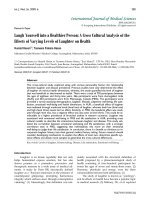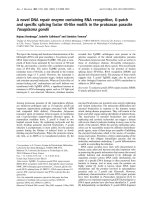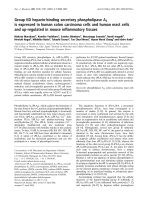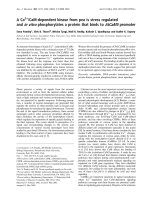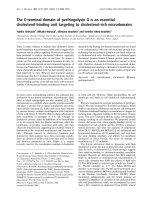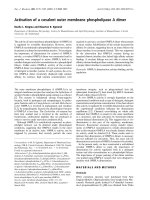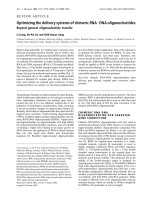Báo cáo y học: " APOBEC3G encapsidation into HIV-1 virions: which RNA is it?" pptx
Bạn đang xem bản rút gọn của tài liệu. Xem và tải ngay bản đầy đủ của tài liệu tại đây (237.84 KB, 2 trang )
BioMed Central
Page 1 of 2
(page number not for citation purposes)
Retrovirology
Open Access
Commentary
APOBEC3G encapsidation into HIV-1 virions: which RNA is it?
Klaus Strebel* and Mohammad A Khan
Address: Laboratory of Molecular Microbiology, National Institute of Allergy and Infectious Diseases, National Institutes of Health, 4/312,
Bethesda, MD, 20892-0460, USA
Email: Klaus Strebel* - ; Mohammad A Khan -
* Corresponding author
Abstract
APOBEC3G is a cytidine deaminase with potent antiviral activity. The protein deaminates single-
stranded DNA but is known to bind cellular and viral RNAs. There is increasing evidence that RNA
binding of APOBEC3G is important for packaging into viral particles. However, there is no
consensus yet on the type of RNA involved.
Commentary
APOBEC3G is a cytidine deaminase that was recently
identified as the prime substrate of the HIV-1 viral infec-
tivity factor Vif [1]. In the absence of Vif, APOBEC3G is
packaged into viral cores and potently interferes with virus
replication (for a recent review see [2]). While it is undis-
puted that much of APOBEC3G's antiviral activity comes
from its encapsidation into virions, the mechanism of
APOBEC3G packaging remains under discussion. Several
studies conclude that APOBEC3G packaging is RNA inde-
pendent and mediated by an APOBEC3G:Gag interaction
while others identified a requirement for viral or cellular
RNA in the APOBEC3G packaging process (Figure 1).
The study by Bach et al. [3] attempts to shed light onto the
mechanism of APOBEC3G packaging. As far as the
requirement of NC for packaging of 7SL RNA is con-
cerned, the authors' data are in good agreement with a
previous report by Wang et al. [4] showing that deletion
of NC reduced packaging of 7SL RNA. Bach et al. disagree,
however, with two other reports who found no significant
NC-dependence for 7SL packaging [5,6]. Thus, the vote is
tied at 2:2 on this issue. As far as the requirement of 7SL
RNA for the packaging of APOBEC3G is concerned, Bach
et al. fail to observe a correlation between APOBEC3G
packaging and 7SL RNA incorporation. They therefore
side with Khan et al. who previously also failed to see such
a correlation [6]. Thus, the score is 2:1 against an involve-
ment of 7SL RNA in the packaging of APOBEC3G. Unfor-
tunately, Bach et al. did not analyze the importance of
genomic RNA for APOBEC3G packaging, an issue on
which Wang and Khan disagree. The score on that issue
therefore remains tied at 1:1. Svarovskaia et al. also
remain neutral on this issue by proposing that incorpora-
tion of APOBEC3G into HIV-1 virions involves both viral
and nonviral RNAs [7].
There clearly is a trend in the field to accept the impor-
tance of RNA in the packaging of APOBEC3G into HIV-1
virions. But which RNA is it? There is no simple answer to
this conundrum. Bach et al. point out that they and Wang
et al. use a highly quantitative assay for determining
encapsidation of 7SL RNA. So part of the difference may
be attributed to differences in sensitivity. Some of the con-
fusion may also come from the use of different experi-
mental model systems, i.e. virus-like particles (VLP)
versus whole virus. Also, it often is not appreciated that
packaging of APOBEC3G into HIV virions or VLPs is as
much a qualitative as it is a quantitative problem. For
instance, the cytidine deaminase APOBEC3A is packaged
Published: 2 July 2008
Retrovirology 2008, 5:55 doi:10.1186/1742-4690-5-55
Received: 11 June 2008
Accepted: 2 July 2008
This article is available from: />© 2008 Strebel and Khan; licensee BioMed Central Ltd.
This is an Open Access article distributed under the terms of the Creative Commons Attribution License ( />),
which permits unrestricted use, distribution, and reproduction in any medium, provided the original work is properly cited.
Publish with BioMed Central and every
scientist can read your work free of charge
"BioMed Central will be the most significant development for
disseminating the results of biomedical research in our lifetime."
Sir Paul Nurse, Cancer Research UK
Your research papers will be:
available free of charge to the entire biomedical community
peer reviewed and published immediately upon acceptance
cited in PubMed and archived on PubMed Central
yours — you keep the copyright
Submit your manuscript here:
/>BioMedcentral
Retrovirology 2008, 5:55 />Page 2 of 2
(page number not for citation purposes)
into HIV virions but does not associate with viral cores
and has no antiviral activity [8]. However, when the pro-
tein is artificially targeted to viral cores, APOBEC3A does
develop antiviral properties [8,9]. Thus investigating
APOBEC3G packaging into VLP rather than intact virions
may allow the investigation of the quantitative aspect of
APOBEC3G packaging but may fail to consider the quali-
tative aspect. Finally, protein overexpression is becoming
an increasing concern in the APOBEC field. Some of the
discrepant results on the role of RNA in the packaging of
APOBEC3G into HIV-1 virions could potentially be
explained by relative differences in protein expression.
In conclusion, the final verdict on what RNA guides the
packaging of APOBEC3G into HIV-1 virions is still out
and awaits further investigation. In particular, it remains
to be determined whether APOBEC3G encapsidation
entails a specific (e.g. viral RNA) and/or a non-specific
component (e.g. cellular RNA). However, it is our (not
completely unbiased) opinion that viral genomic RNA is
excellently placed to make the finals.
Competing interests
The authors declare that they have no competing interests.
Authors' contributions
KS wrote the first draft and MAK made critical suggestions
for improvement. All authors read and approved the final
manuscript.
Acknowledgements
KS is supported by a Grant from the NIH Intramural AIDS Targeted Anti-
viral Program and by the Intramural Research Program of the NIH, NIAID.
References
1. Sheehy AM, Gaddis NC, Choi JD, Malim MH: Isolation of a human
gene that inhibits HIV-1 infection and is suppressed by the
viral Vif protein. Nature 2002, 418:646-650.
2. Goila-Gaur R, Strebel K: HIV-1 Vif, APOBEC, and Intrinsic
Immunity. Retrovirology 2008, 5:51.
3. Bach D, Peddi S, Mangeat B, Lakkaraju A, Strub K, Trono D: Charac-
terization of APOBEC3G binding to 7SL RNA. Retrovirology
2008, 5(1):54.
4. Wang T, Tian C, Zhang W, Luo K, Sarkis PT, Yu L, Liu B, Yu Y, Yu
XF: 7SL RNA mediates virion packaging of the antiviral cyti-
dine deaminase APOBEC3G. J Virol 2007, 81:13112-13124.
5. Onafuwa-Nuga AA, Telesnitsky A, King SR: 7SL RNA, but not the
54-kd signal recognition particle protein, is an abundant
component of both infectious HIV-1 and minimal virus-like
particles. RNA 2006, 12:542-546.
6. Khan MA, Goila-Gaur R, Opi S, Miyagi E, Takeuchi H, Kao S, Strebel
K: Analysis of the contribution of cellular and viral RNA to
the packaging of APOBEC3G into HIV-1 virions. Retrovirology
2007, 4:48.
7. Svarovskaia ES, Xu H, Mbisa JL, Barr R, Gorelick RJ, Ono A, Freed EO,
Hu WS, Pathak VK: Human apolipoprotein B mRNA-editing
enzyme-catalytic polypeptide-like 3G (APOBEC3G) is incor-
porated into HIV-1 virions through interactions with viral
and nonviral RNAs. J Biol Chem 2004, 279:35822-35828.
8. Goila-Gaur R, Khan MA, Miyagi E, Kao S, Strebel K: Targeting
APOBEC3A to the viral nucleoprotein complex confers anti-
viral activity. Retrovirology 2007, 4:61.
9. Aguiar RS, Lovsin N, Tanuri A, Peterlin BM: Vpr.A3A Chimera
Inhibits HIV Replication. J Biol Chem 2008, 283:2518-2525.
10. Khan MA, Kao S, Miyagi E, Takeuchi H, Goila-Gaur R, Opi S, Gipson
CL, Parslow TG, Ly H, Strebel K: Viral RNA is required for the
association of APOBEC3G with human immunodeficiency
virus type 1 nucleoprotein complexes. J Virol 2005,
79:
5870-5874.
Mechanism of APOBEC3G encapsidationFigure 1
Mechanism of APOBEC3G encapsidation. Four differ-
ent scenarios can be envisioned: (1) APOBEC3G is packaged
non-specifically. This possibility seems unlikely given the
known affinity of APOBEC3G to viral Gag proteins and viral
and cellular RNAs. (2) APOBEC3G is packaged through
interaction with Gag in an RNA-independent manner. Such a
mechanism was initially proposed as discussed in the text. (3)
APOBEC3G interacts with host RNA; in particular 7SL RNA
was proposed to mediate encapsidation of APOBEC3G. (4)
APOBEC3G is packaged through specific interaction with
viral genomic RNA. This model is our favorite and is sup-
ported by the observation that point mutations in the 5'
untranslated region of the viral genome can severely affect
APOBEC3G packaging without affecting 7SL RNA encapsida-
tion [6,10]. This model is also consistent with the data
reported by Bach et al. [3].
